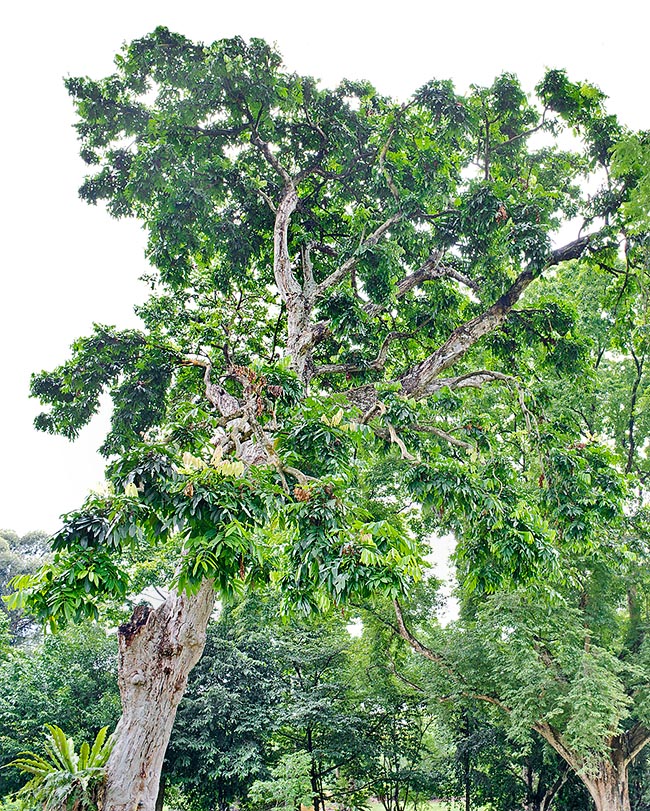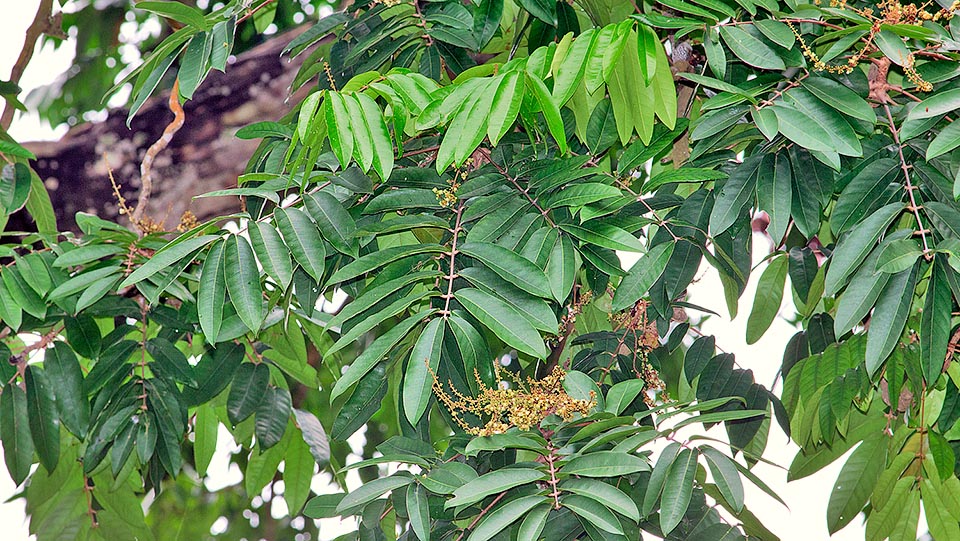Family : Meliaceae

Text © Pietro Puccio

English translation by Mario Beltramini

At home in Caribbean and tropical South America pluvial forests and along the rivers up to about 1200 m of altitude, Carapa guianensis is a 20-50 m tree with tabular roots and 0,6-1,5 m of diameter trunk © G. Mazza
The name of the genus is that utilized by the Kali’na (in the old times called Galibi by the Europeans), indigenous people of the Caribbean coasts of South America; the specific Latin name “guianensis” = of Guyana refers to the place of origin of the specimen type on which has been described the species.
Common names: andiroba, Brazilian mahogany, crabwood, royal mahogany (English); andiroba, carapa, bois rouge (French); andiroba, andiroba branca, andiroba-do-igapó, andiroba-saruba, canapé carapa, carapinha, castanha-mineira, iandiroba, iandirova, nandiroba (Portuguese-Brazil); andiroba, andiroba vermelha, cabrima de guiana, caobilla, cedro cóbano, cedro macho, mazabalo (Spanish); Läuseholz (German).
The Carapa guianensis Aubl. (1775) is a deciduous or semi-deciduous tree, 20-50 m tall, with erect cylindrical trunk, of 0,6-1,5 m of diameter, provided at the base of tabular roots (flattened roots similar to buttresses that contribute in supporting the big trees) up to 2,5 m tall, with greyish or greyish brown bark irregularly fissured.
The leaves, on a 30 cm long petiole, are alternate, paripinnate, 30-60 cm long, with 4-9 pairs of opposite or sub-opposite leaflets, oblong-ovate with entire margin and pointed apex, 10-30 cm long and 4-7 cm broad, coriaceous, glossy intense green above, opaque below. Panicle axillar or sub-terminal inflorescences, erect, 20-60 cm long, with sub-sessile unisexual flowers on the same inflorescence, of about 1 cm of diameter, fragrant, with pale green calyx having 4 (5) about 1 mm long lobes, 4 (5) white or cream petals, obovate to elliptic, about 5 mm long, and about 3 mm long staminal tube.
The fruit is a dehiscent sub-globose woody capsule, quadrangular, of 9-14 cm of diameter, with 4 lobes, containing 2-4 angled seeds per lobe of pale brown colour and of particularly bitter taste; the seeds float and are mainly dispersed by the water
It reproduces by seed, that must be fresh having a very short lasting germinability, in loam rich of organic substance maintained humid at the temperature of 26-28 °C, with germination times of about three weeks, the times may be reduced to one week previous scarification, and by cutting.

Oblong-ovate leaves reaching 30 cm and erect 20-60 cm inflorescences. The hard wood, pale pink to brown reddish, darkening with time, is durable and easy to work. Often used in lieu of mahogany for prestigious furniture. The oil gotten from the seeds is used in the cosmetic industry and has medicinal virtues © Giuseppe Mazza
Massive tree of fast growth suitable exclusively to the tropical and humid subtropical regions with high annual rainfall, requires full sun to grow better, or slight shade, and is not particular about the soils, even swampy, but prefers those rich of organic substance; is often utilized in the origin places as ornamental. The wood, of pale pink to brown-reddish colour, darkening with the time, is hard, resistant, durable, easy to work and resistant to the termites, that can be utilized in place of mahogany (Swietenia macrophylla) for prestigious furniture, in the constructions of the dwellings for frames, floors, stairs and partitions, and for inner parts of boats and planes.
The oil extracted from the seeds is utilized in the cosmetic industry, in the soaps one, for odourless insect-repellent candles and locally for illumination; along with the bark and the leaves is employed since remote times in the traditional medicine, in particular of the Amazonian tribes, for the skin diseases and as analgesic, antinflammatory, antipyretic and antibacterial.
Synonyms: Persoonia guareoides Willd. (1799); Carapa latifolia Willd. ex C.DC. (1878); Granatum guianense (Aubl.) Kuntze (1891); Guarea mucronulata C.DC. (1917); Carapa macrocarpa Ducke (1922).
→ To appreciate the biodiversity within the MELIACEAE family please click here.
